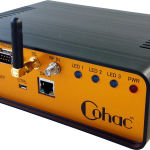 Loradd++ /Corce eLoran/Chayka receiver module. Photo: reelektronika.
Loradd++ /Corce eLoran/Chayka receiver module. Photo: reelektronika.Designed to deliver a breakthrough in size reduction and lower power needs, reelektronika announces the development of a new series of integrated eLoran/Chayka/GNSS receivers based on the Loradd++ core which extends the range of currently produced receivers.
The need to significantly reduce the size and power consumption of receivers was the main driver of this development, according to Reeuwijk, Netherlands-based Reelektronika. Low power and small size are among the prerequisites for developing wearable instruments.
Designed to deliver a breakthrough in size reduction and lower power needs, reelektronika announces the development of a new series of integrated eLoran/Chayka/GNSS receivers based on the Loradd++ core which extends the range of currently produced receivers.
The need to significantly reduce the size and power consumption of receivers was the main driver of this development, according to Reeuwijk, Netherlands-based Reelektronika. Low power and small size are among the prerequisites for developing wearable instruments.
With GNSS playing key roles today, alternative positioning, navigation and timing (PNT) becomes an essential need to reduce risks of GNSS denials. eLoran and Chayka are recognized as solid alternative PNT systems, but the current receivers on the market are rather large compared to miniature GNSS devices, which limits portable eLoran/Chayka usage requiring very small volume and low power consumption.
The resulting new product Loradd++ meets these two requirements and resulted in a receiver board of 60x30x8 millimeters, consuming less than 500 milliwatts (3.3 volts) in continuous operation. The Loradd++ can be used with either E-field or H-field antennas, features dual serial interface for integrated systems, and it is connectable to u-blox GNSS receiver modules.
Based on the Loradd++, reelektronika is developing a series of receivers, the first of which is the Loradd++/E, which is an integration of the Loradd++ with an E-field antenna housed in a small single radome which can be connected via a data cable (up to 150 meters) and a dongle to a USB port on a PC.
The radome contains a u-blox M8T GNSS receiver with antenna and measures a height of 135 millimeters and a diameter of 85 millimeters. The Loradd++/E needs less than 700 milliwatts at 4-16 volts.
At this week’s Munich Satellite Summit 2017, there’s a panel discussion titled “GNSS — is it time for backup?” that addresses today’s needs for a robust backup as the threats of GNSS denial increase. Threats to PNT can produce serious problems to daily life and the economy, the company said, and years of study in the United States as well in Europa and Asia indicated that eLoran/Chayka is a promising, efficient GNSS backup. Reelektronika sees this as a sound reason to continue research and development of new eLoran/Chayka-based PNT systems.





